
The California Native Plant Society (CNPS) is a California environmental non-profit organization that seeks to increase understanding of California's native flora and to preserve it for future generations. The mission of CNPS is to conserve California native plants and their natural habitats, and increase understanding, appreciation, and horticultural use of native plants throughout the entire state and California Floristic Province.
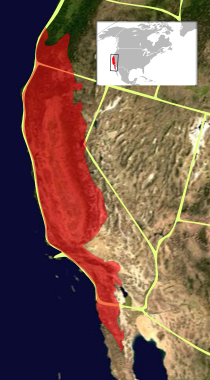
The California Floristic Province (CFP) is a floristic province with a Mediterranean-type climate located on the Pacific Coast of North America with a distinctive flora similar to other regions with a winter rainfall and summer drought climate like the Mediterranean Basin. This biodiversity hotspot is known for being the home of the Sierran giant sequoia tree and its close relative the coast redwood. In 1996, the Province was designated as a biodiversity hotspot allowing it to join ranks among 33 other areas in the world with many endemic species. To be named a biodiversity hotspot, an area has to contain species and plant life that cannot be found anywhere else in the world. The California Floristic Province is home to over 3,000 species of vascular plants, 60% of which are endemic to the province.

Helodium blandowii, also known as Blandow's helodium moss, Blandow's tamarisk-moss, Blandow's bogmoss, and Blandow's feathermoss, is a rare plant in the Western U.S., including Oregon and California. It occurs all around the northern hemisphere in higher latitudes, and in some places is not as rare as in the Western U.S.

Eriodictyon capitatum, the Lompoc yerba santa, is a rare evergreen shrub in the borage family. It is endemic to western Santa Barbara County, in California.
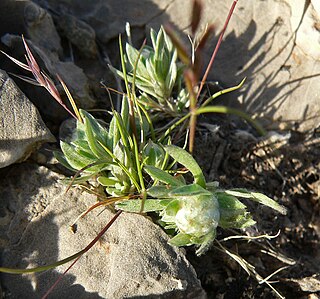
Stylocline(neststraw) is a small genus of North American desert plants in the tribe Gnaphalieae within the family Asteraceae.

Ancistrocarphus is a genus of flowering plants in the family Asteraceae. It contains two known species, both native to western North America. These plants are often treated as members of genus Stylocline, but they are not as closely related to Stylocline species as they are to plants of other genera, especially Hesperevax.

Arctostaphylos glandulosa, with the common name Eastwood's manzanita, is a species of manzanita.

Dudleya stolonifera is a succulent plant known by the common name Laguna Beach liveforever or Laguna Beach dudleya. This is a rare plant which is endemic to the coastline of Orange County, California. It is known from only about six populations in the vicinity of Laguna Beach, totaling about 30,000 individuals. It is federally listed as a threatened species of the United States.

Berberis nevinii, known by the common name Nevin's barberry, is a species of flowering shrub in the barberry family.

Lepechinia ganderi is a rare species of perennial shrub in the mint family known by the common name San Diego pitcher sage or Gander's pitcher sage. An aromatic plant with white to lavender flowers, this species is only known from southern San Diego County in California and a small portion of Baja California, occurring on chaparral or coastal sage scrub in metavolcanic soils. Because of its limited range, it is under threat from growing urbanization and increased fire frequency.

Arctostaphylos densiflora, known by the common name Vine Hill manzanita, is a very rare species of manzanita. It is endemic to Sonoma County, California, where it is known from only one extant population of 20 to 30 individual plants. These last wild members of the species are on land near Sebastopol which is owned and protected by the California Native Plant Society. In addition, there are five to ten plants of this manzanita taxon growing on private property about a mile away. The local habitat is mostly chaparral on sandy shale soils.
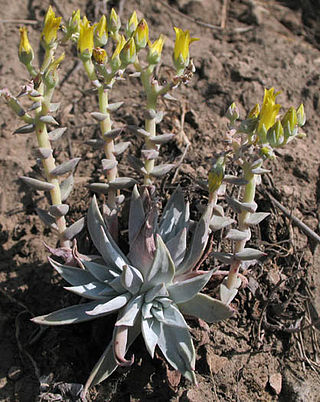
Dudleya verityi is a rare species of succulent plant known by the common name Verity's liveforever. It is endemic to Ventura County, California, where it is known from only three occurrences in the vicinity of Conejo Mountain between Camarillo and Thousand Oaks. It probably occurs in a few additional locations nearby which have not yet been officially vouchered.
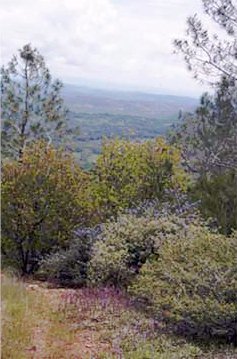
Pine Hill Ecological Reserve is a nature reserve of 403 acres (1.63 km2) located due east of Folsom Lake in the Sierra Nevada foothills, in El Dorado County, California. The reserve was established in 1979, and is managed by the Bureau of Land Management.
The Bonny Doon Ecological Reserve is a nature preserve of 552 acres (2.23 km2) in the Santa Cruz Mountains of California, United States. The reserve protects several rare and endangered plant and animal species within an area known as the Santa Cruz Sandhills, an ancient seabed containing fossilized marine animals.

Thermopsis macrophylla is a species of flowering plant in the legume family known by the common names Santa Inez goldenbanner and Santa Ynez false-lupine.

Ancistrocarphus filagineus is a North American species of flowering plants in the family Asteraceae, known by the common names woolly fishhooks and hooked groundstar. It is native to western North America, including Idaho, Oregon, Nevada, California, and Baja California.

Adiantum viridimontanum, commonly known as Green Mountain maidenhair fern, is a fern found only in outcrops of serpentine rock in New England and Eastern Canada. The leaf blade is cut into finger-like segments, themselves once-divided, which are borne on the outer side of a curved, dark, glossy rachis. These finger-like segments are not individual leaves, but parts of a single compound leaf. The "fingers" may be drooping or erect, depending on whether the individual fern grows in shade or sunlight. Spores are borne under false indusia at the edge of the subdivisions of the leaf, a characteristic unique to the genus Adiantum.
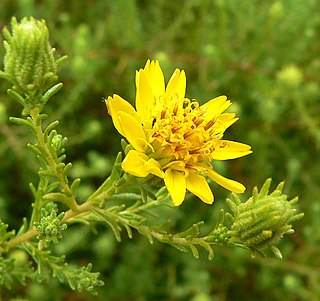
Deinandra minthornii — — is a rare California species of flowering plant in the family Asteraceae known by the common name Santa Susana tarplant, or Santa Susana tarweed. It is listed as a rare species by the California Department of Fish and Wildlife and on the California Native Plant Society Inventory of Rare and Endangered Plants of California.

Holmgrenanthe petrophila is a rare perennial desert plant in the plantain family (Plantaginaceae), and the sole species of the genus Holmgrenanthe. It forms low mats of branched stems growing from a woody base. The leaves have small spines along their edges. The solitary yellow flowers are tubular with five free lobes at the end, the upper two pointing backwards, the lower three projecting forwards. The species is known only from about ten locations, most in the Titus Canyon and the adjacent Fall Canyon, all within the Californian section of Death Valley National Park. It grows in limestone crevices on the canyon walls, often on the north face.
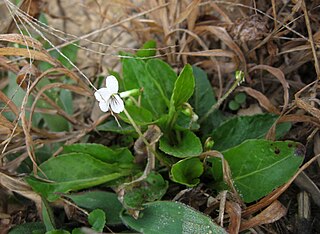
Viola primulifolia, commonly called the primrose-leaf violet, is a species of flowering plant in the violet family. It is native to eastern North America, and possibly also to the Pacific Northwest. Its natural habitat is wet acidic areas that are usually at least semi-open.



















